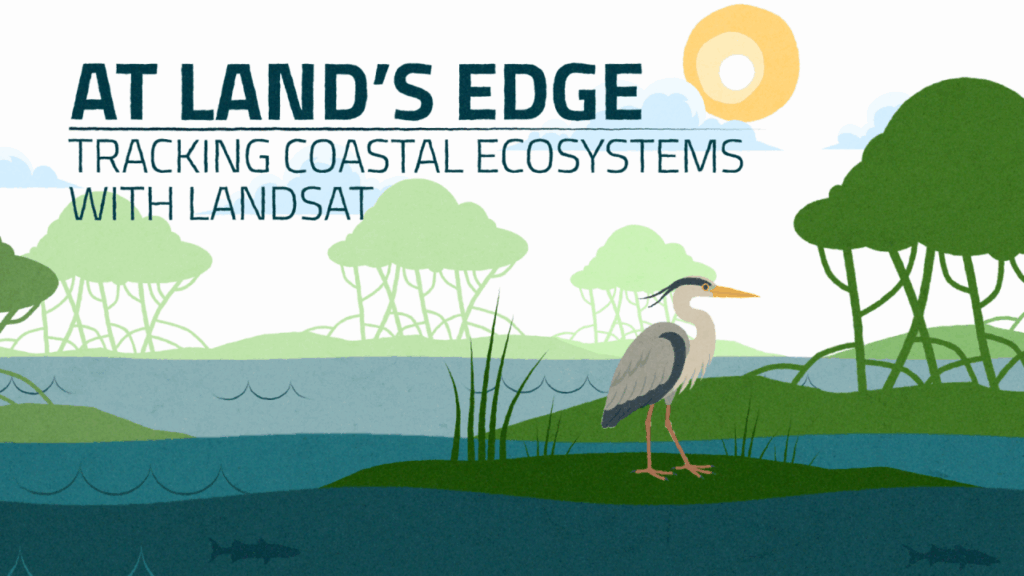

As the workhorses for Earth science from space, Landsat satellites have imaged Earth’s land surfaces uninterrupted for over 50 years. The missions continue to execute on the big idea of consistent, long-term observations. But limiting observations to land would have kept Landsat from its full potential.
Scientists at the U.S. Geological Survey have developed a new way to measure ocean depth, or bathymetry, in shallow nearshore environments using Landsat data. By applying a sophisticated physics-based algorithm to satellite observations, their method offers an expedient way to map the seafloor from space without relying on prior depth measurements. Deriving bathymetry from satellites—a process researchers have been refining for decades—can fill in many mapping gaps in coastal areas and provide up-to-date information critical for modeling water movement, tracking coastal changes, studying coral reef habitats, and more.
The new method, described in a 2024 paper in the journal Remote Sensing, relies upon visible-light observations by the OLI (Operational Land Imager) and OLI-2 (Operational Land Imager-2) sensors on the Landsat 8 and 9 satellites, coupled with a heavy dose of physics calculations. In shallow enough seas, sunlight penetrates the water and reflects off the seafloor. Scientists can then relate the reflected light as “seen” by the satellite to water depth.
The calculation is relatively straightforward in clear water with a bright bottom. But it becomes more complex, for example, when light interacts with sediment or plankton in the water column or a grass-covered seafloor. The USGS researchers developed the algorithm to correct for these types of effects on reflected light, as well as those caused by particles in the atmosphere and the reflection of the sky off the water, to determine water depth.
This algorithm was applied to several coastal areas containing coral reefs, including the Florida Keys, shown here. The depth map (right) shows shallow channels cutting between low-lying islands, also called cays or keys. The shallow linear feature running across the bottom of the image is part of Florida’s stretch of coral reefs, which spans 350 miles (560 kilometers) from end to end. The bathymetric map is shown relative to a natural-color Landsat image of the same area (left).
In clear water, it is possible to map depths greater than 20 meters (65 feet), much deeper than expected, said Minsu Kim, the remote sensing and ocean optics expert who led the method’s development. Crucially, the method works without external calibration, although it can be refined by incorporating bathymetry measurements from other sources. The tradeoff is that the model accounts for the optical properties of common ocean components, such as phytoplankton and suspended solids in the water column, and grass or sand on the seafloor. If uncommon components such as a bloom of a specific phytoplankton species or a rare kind of dark volcanic sea floor are present, the model becomes less accurate.
Coral reef zones were good candidates for piloting this method because they influence sediment transport, affect coastal erosion, and provide critical habitat to much of the world’s marine life, said physical geographer Jeff Danielson, co-author of the paper and leader of the USGS Coastal National Elevation Database (CoNED) Applications Project. These environments can also change dramatically over time and would benefit from more frequent re-mapping made possible by satellite-derived bathymetry.
Despite the need for refined shallow-water maps, however, producing them has remained a practical and technical challenge. Bathymetric mapping has traditionally relied upon ship-based sonar and aircraft-based lidar—both cost- and labor-intensive endeavors.
The quest to outsource this onus to satellites includes a pioneering effort by oceanographer Jacques Cousteau. In the 1975 NASA-Cousteau Bathymetry Experiment, Cousteau and a team of divers aboard the Calypso played leapfrog with the Landsat 1 and 2 satellites around the Bahamas and Florida. They would position themselves directly underneath each day’s satellite pass, and divers would measure water clarity, light transmission, and bottom reflectivity. Data from the trip showed that in clear waters with a bright seafloor, Landsat could measure depths up to 22 meters (72 feet).
The cross-purposing of remote sensing instruments for bathymetry has continued from there. Subsequent techniques have included using turbidity as imaged by Landsat as a proxy for depth; combining altimetry measurements from NASA’s ICESat-2 (Ice, Cloud, and land Elevation Satellite-2) with ship-based sonar; deriving depth from stereo imagery; and applying an algorithm to digital photography from the International Space Station.
With the new satellite-based method in hand, Kim, Danielson, and colleagues are looking to scale up nearshore measurements. For example, they want to map waters around Pacific islands and atolls, where data is currently lacking but would be useful for modeling waves, sediment transport, and other processes. Maps are also blank for large portions of coastal Alaska, where hazards including harsh weather, seasonal sea ice, and strong currents have made conventional mapping work difficult.
In the United States alone, coastal waters are currently only 52 percent mapped, Danielson noted. Initiatives such as the National Ocean Mapping, Exploration, and Characterization (NOMEC) and the global Seabed 2030 project are working to increase mapping coverage, alongside the USGS’s CoNED pursuit to assimilate data that now includes Landsat-derived water depth. “It’s one of the hot topics in geospatial sciences right now,” said Danielson. “There is a niche to fill in bathymetry gaps with a new tier of data.”





